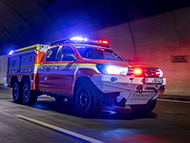From Prospeed Motorsport Press Release
The booming number of electric vehicles on the roads may be considered good for the environment, but it is causing concern among fire fighters. Although electric vehicles are statistically less likely to catch fire than an internal combustion engine car, incidents involving a lithium-ion battery can be far more serious and difficult to extinguish – especially if in an enclosed space such as an underground or multi-storey car park which large fire engines cannot access.
Once a battery pack has been compromised by an accident or external fire, it can be difficult to tackle the resulting blaze as the energy contained with the cells is released, causing a ‘thermal runaway’. Previous ways of preventing this or fighting the fire involve extreme measures such as immersing the entire car in water for days in large bags or shipping containers.
A new, more practical way of tackling these incidents has been developed along with a new rapid intervention vehicle which can deliver the crew and equipment to locations where height may be limited, such as car park structures.
This, in combination with traditional firefighting techniques, can help prevent large fires escalating such as the recent incidents at Kings Dock car park in Liverpool and Stavanger Airport in Norway.
In these cases, none of the large fire and rescue vehicles were able to enter the structures in the early stages of the fire due to height restrictions. By the time crews entered on foot with fire-fighting equipment and water, the fire had developed beyond control. The resulting devastation led to thousands of cars being destroyed, an airport and venue being closed followed by costly re-building.
Industry specialists have co-operated to develop a new generation of fire fighting vehicle, developed specifically to fight both conventional and Electric Vehicle fires in car parks at the early stages - wherever the location.
HILOAD 6x6:
The basis of the Rapid Intervention Vehicle is the British-built HILOAD, engineered by Prospeed Motorsport in York, England. Its engineering led approach uses a Toyota Hilux as a donor, fitted with an entirely new chassis to avoid a compromised ‘cut and shut’ of the original frame.
With the replacement chassis and a torque splitter system, the 6x6 has rated 5,600kg Gross Vehicle Weight, which offers 3,000kg payload. That’s almost triple the standard 4x4 Hilux’s capacity, and the load-space is also extended by 1,230mm.
Although longer, The HILOAD’s height is just 1,850mm - less than some large SUVs and low enough to allow access to the majority of parking structures. It also results in a lower centre of gravity and better stability in high-speed manoeuvres.
ColdCut - Cobra
Among the other equipment which the increased payload helps carry, the HILOAD can be fitted with the Coldcut Cobra system for extinguishing EV battery fires.
The Cobra Ultra High Pressure Lance (UHPL) system uses an abrasive suspended in water to pierce a hole through floor pans and inject water at 300bar – more than 100 times the pressure of the air in a typical car tyre – throughout the module casing . This water cools directly inside the battery and thus prevents propagation and further possibility of a thermal runaway.
Unlike alternatives which involve pumping thousands of litres of water into the vehicle in an attempt to cool the whole battery, independent tests from the Swedish Civil Contingencies Agency showed the Coldcut Cobra system could prevent cell propagation within 10 minutes, using just 240 litres of water – that’s less than a bath-full and 20% of the HILOAD’s tank capacity.
Away from urban car park environments, the enhanced traction and reduced ground pressure resulting from a 6-wheel drive set-up can also prove invaluable for tackling fires in remote and challenging environments such as forests and heathland. The HILOAD can get to these fires faster while carrying more crew, water and equipment into wild terrain.
A HILOAD is currently being trialled in the Czech Republic, with the vehicle specifically developed to tackle EV battery fires and assist with fast response occupant extraction. It is already part of one EV car manufacturer’s firefighting fleet.
Prospeed are also working in the defence market to offer a 4x4 HILOAD with a 5,000kg GVW and a 6x6 HILOAD with 6,500Kgs GVW as part of a light utility vehicle fleet, which will replace ageing Land Rover Defender and Pinzgauer fleets.
The HILOAD is assembled in York in the UK, or the company can ship the 6x6 conversion as a module for final assembly in an export market. The design can also be licenced for higher volume production.



